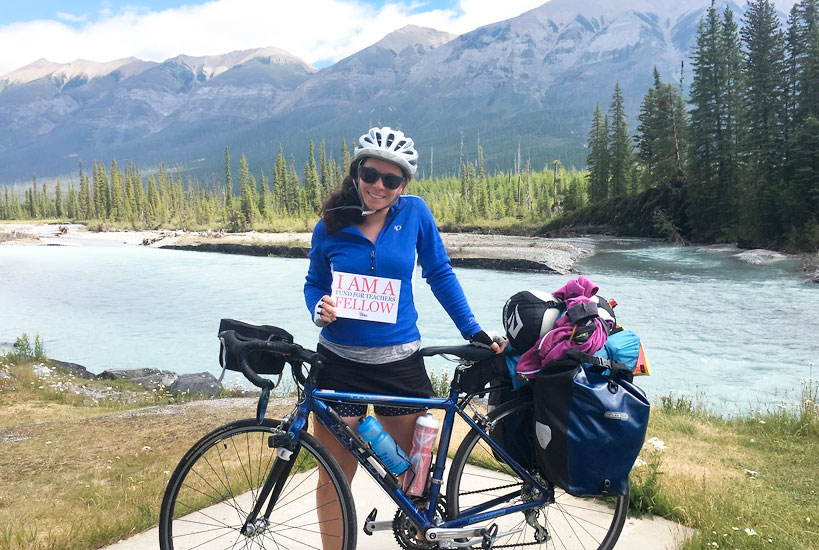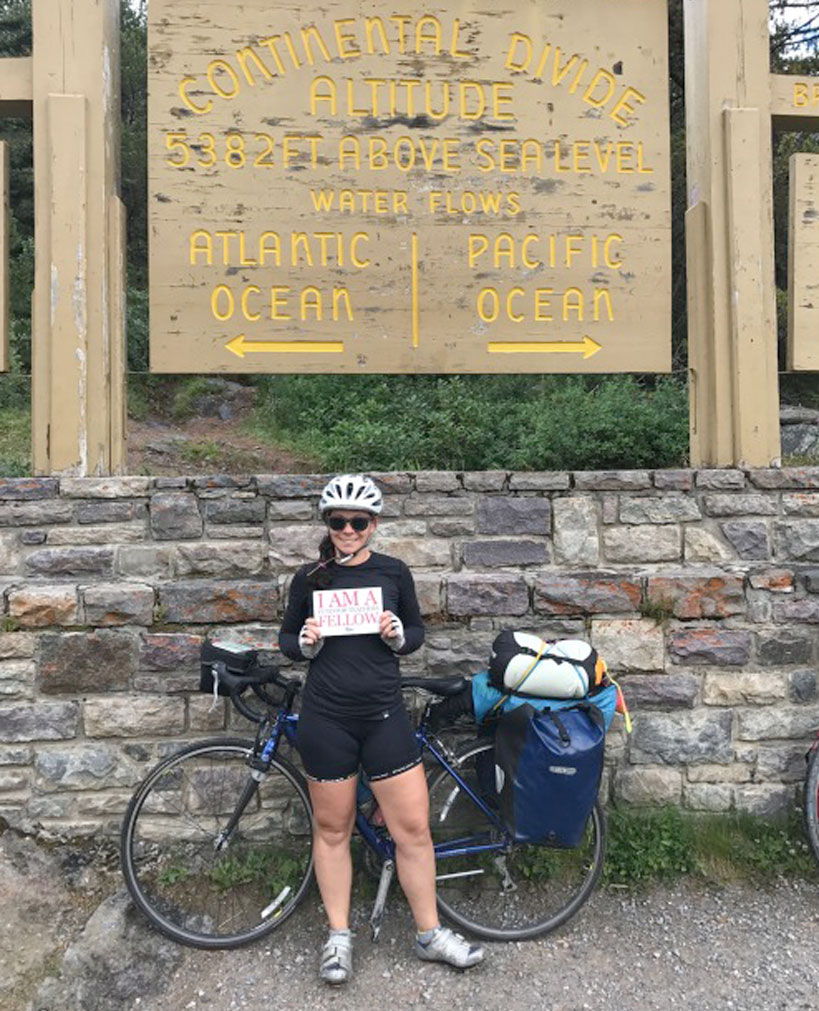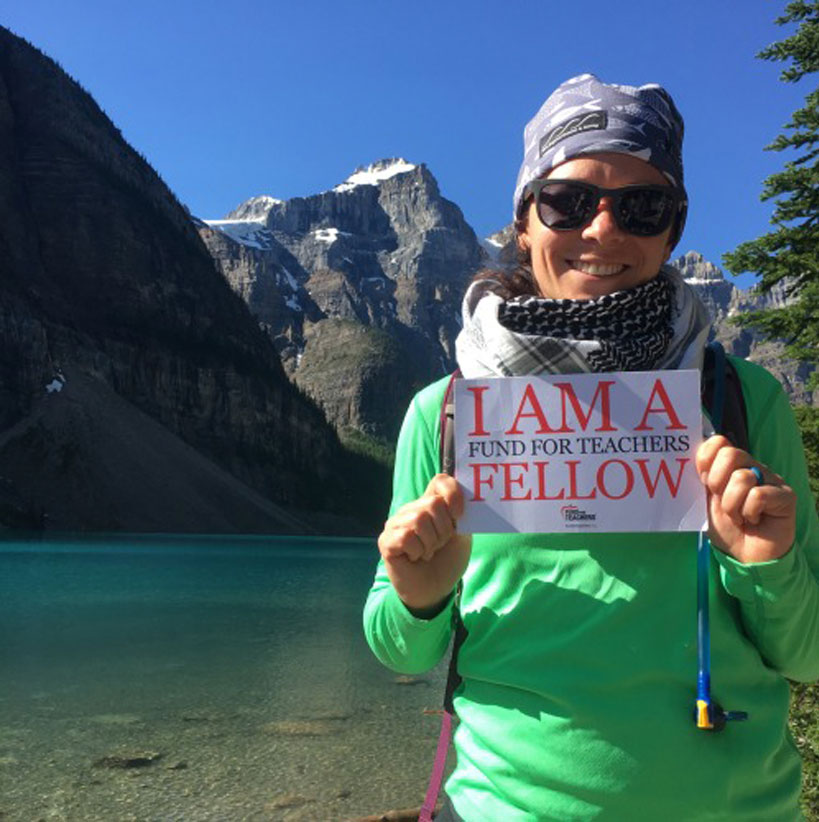Miles and Miles of Math

by Alyson Parenteau
Science Technology Magnet High School | New London, CT
As a math teacher, the most common question my students ask is, “When am I ever going to use this?” In response, I’ve organized Making Math Career Connections days, when community members come into the classroom and tell us how they use math in their lives. Engineers, computer scientists, members of the military, medical professionals and business people talk about how they use math in their jobs and industries. However, my students resonate more with people who talk about using math outside of work, in their hobbies and personal interests. When one guest talked about his 3,700 mile cross country bicycle trip, my students were wide eyed and mesmerized. Talk about using math flowed effortlessly as students asked How long the trip was both (in time and miles? How much did it cost? Where did you stay? What did you eat? and What sort of issues did you have?
I enjoy riding my bike and was also inspired by this long adventure, but I didn’t think I was ready for a cross country trek for curriculum’s sake. After I found a bike tour of the Great Parks North with Adventure Cycle Association, I felt like that was something I could tackle and I started my Fund for Teachers proposal to cycle 800 miles from Missoula, MT, to Jasper, Alberta, Canada.
My goal was to create real world math calculations and connections for my students and to model personal growth, perseverance and grit. I wanted to see what other math connections I could discover from the seat of my bicycle. I am a firm believer that math is all around us, we just have to make sure we’re looking hard enough.
- Looking at the trip route, I was calculating total mileage, daily and average mileage, vertical assent and decent, speed, time to complete the daily ride, the rate I’d likely be traveling and the impact of road grades.
- Reading the maps, I applied scale factors and used my compass rose to help figure out where I was and where I was going.
- Packing for the trip, I was concerned about the weight of the gear I was carrying translating into a more difficult ride and wanted to make sure I was carry enough ounces of water and electrolyte replacement to stay hydrated.
- Pedaling, I was also running numbers with nutrition thinking about my calories consumed and how many calories I was burning.
In the farmland of Montana, as we passed hay bales, I wanted to measure the volume of the cylinders and the rectangular prisms to see if there was a benefit to how they were packed. I pondered how you would then go about calculating the surface area that each bale would cover. I continued to think about geometry in how my bike was designed, the frame made of triangles and how much smaller my bike frame was as a 5’ tall person, compared to another rider that’s 6’ 4″. Climbing the Canadian Rockies in the lowest gear of my bicycle chain, most affectionately known as the granny gear, I wanted to go back to my bike mechanic and understand how the cogs work together in the chain ratio to make climbing most efficient. At one point, as we were crossing the continental divide, one of my fellow adventures shared with me their observation that the speed we were going up hill was just under 3 mph, and we could probably walk fast than we were riding.
You really get a lot of time to think when your objective is to pedal six hours in a day. I thought about what we call distance/time graphs in algebra and how we often write a story to describe a situation and have students match a graph and table to the situation. For example:
“Mrs. Parenteau leaves camp at a rate of 13 mph with fresh legs in the morning. She stops for second breakfast at The Greatful Bread for 15 minutes. She gets back on her bike and rides up a big hill, down it and then stops for lunch. She then leisurely rides into camp at a rate of 10 mph.”
The question would match to a graph that increased my distance over time, but with speeds that relate to the story and flat lines where I’m stopped for lunch. Other real life word problems I started thinking about was solving a system of equations where my friend and I travel at different speeds and I might need a head start in order for us to meet for lunch together. All and all, I didn’t realize there was so much math involved, but I am so excited to bring it to my students this year!

I vividly remember a startling math moment. Our total mileage for the day was 72 miles. I had been riding for several hours and watching the mile markers decrease as we approached our destination. I think the last marker I had seen was something about 40ish miles left to our camp destination. Then, the next marker said 63. I thought to myself, HOW in the world, did I end up going backwards?! Then it dawned on me. I had crossed the Canadian Boarder and things were now in km! From there on out, I was trying to come up with the best way to mentally convert between km and miles.
In addition to the math connections, my project had another purpose – to be an example for my students to step out of their comfort zones, embrace challenge and struggle productively. I had never camped before this fellowship and my longest bike ride was 150 miles in two days. Yet, on this fellowship I camped for three weeks, including a couple days of rustic camping, without flushing toilets or access to a shower. I adapted to a new pace, literally traveling through life slower than one is used to in a car. From the seat of my bike, the mountains, glaciers and lakes took my breath away; majestic and beautiful – like nothing I had ever seen. I truly think you take it all in better from your bike than a car.
My sense of accomplishment pedaling into the Columbia Icefields on our second-to-last day was all the more overwhelming having persevered through prior “valleys.” Many times (such as when walking would have been faster than biking) my self talk sounded like: “You just have to go a little bit further. Just keep pedaling. t doesn’t matter how fast you go, each pedal is progress in the right direction. I can do this!” This is the same self talk I want my students to have in and out of the classroom.
Recently, growth mindset has become a buzz word in education. I started this year teaching my students about growth mindset, doing activities to see what they would do if they knew the wouldn’t fail, setting goals, looking at brain development studies and seeing the benefits of making mistakes and learning from them. Yes, this mindset – and my fellowship – totally apply to the math classroom, and also to extracurricular activities and life in general. I believe that by cycling 800 miles in three weeks on a fellowship I designed and pursued, I set an example that encourages my students to take risks. It’s in that stretch zone that we start to grow.

[minti_divider style=”1″ icon=”” margin=”30px 0px 30px 0px”]
Alyson is a middle school mathematics teacher in New London, CT. She is part of the innovative Teach to One team, where students receive an individualized, multi-modality math education. Alyson believes in creating experiential learning opportunities for her students, including field trips, conferences, after school activities and community partnerships.
 Back to Blogs
Back to Blogs